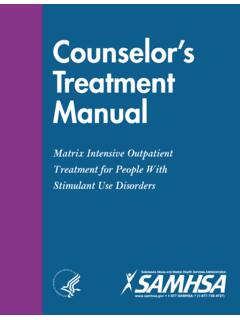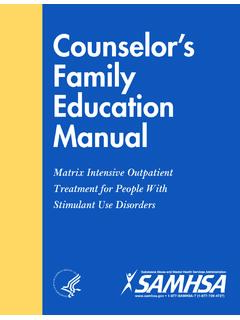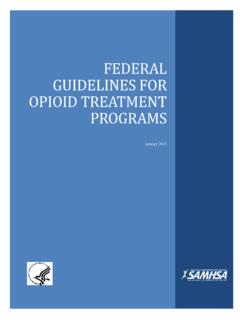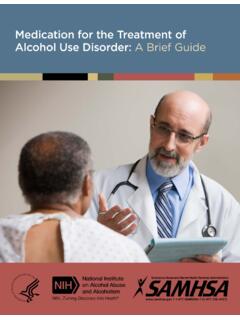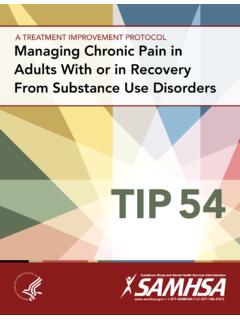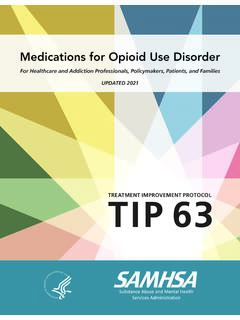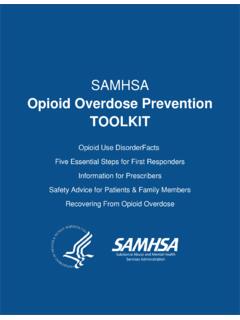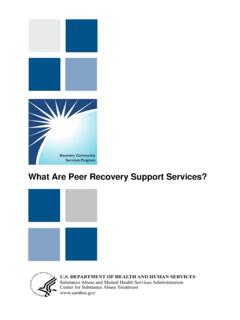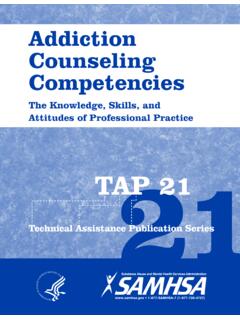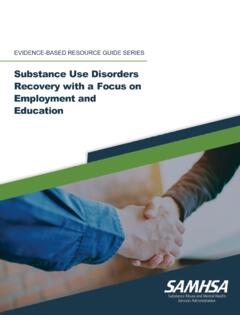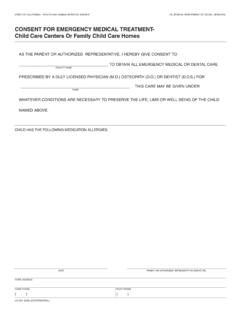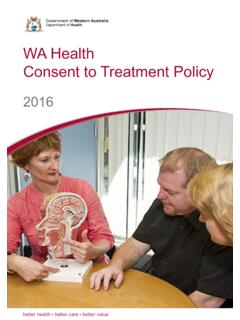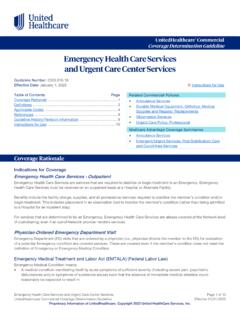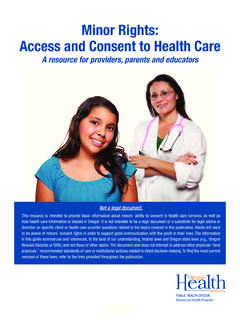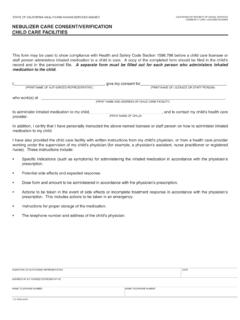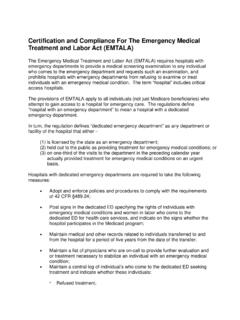Transcription of After an Attempt - Substance Abuse and Mental Health ...
1 After an Attempt A Guide for Taking care of Yourself After Your treatment in the emergency Department Acknowledgements This brochure was originally developed by the National Alliance on Mental Illness ( ) in partnership with the Suicide Prevention Resource Center ( ). under Grant Number SM55029-01 from the Substance Abuse and Mental Health Services Administration (SAMHSA), U. S. Department of Health and Human Services (HHS). Disclaimer The views, opinions, and content of this publication are those of the author and do not necessarily reflect the views, opinions, or policies of SAMHSA or HHS. The listing of non- federal resources in this document is not comprehensive, and inclusion does not constitute endorsement by SAMHSA or HHS. Public Domain Notice All material appearing in this publication is in the public domain and may be reproduced or copied without permission from SAMHSA.
2 Citation of the source is appreciated. However, this publication may not be reproduced or distributed for a fee without the specific, written authorization of the Office of Communications, SAMHSA, HHS. Electronic Access This publication may be downloaded at Recommended Citation Substance Abuse and Mental Health Services Administration. After an Attempt : A Guide for Taking care of Yourself After Your treatment in the emergency Department. HHS Publication No. SMA18-4355 ENG. Rockville, MD: Center for Mental Health Services, Substance Abuse and Mental Health Services Administration, Department of Health and Human Services. Revised 2018. Originating Office Suicide Prevention Branch, Center for Mental Health Services, Substance Abuse and Mental Health Services Administration, 5600 Fishers Lane, Rockville, MD 20857, HHS Publication No.
3 SMA18-4355 ENG. First printed 2006. Revised 2018. Nondiscrimination Notice SAMHSA complies with applicable Federal civil rights laws and does not discriminate on the basis of race, color, national origin, age, disability, or sex. SAMHSA cumple con las leyes federales de derechos civiles aplicables y no discrimina por motivos de raza, color, nacionalidad, edad, discapacidad o sexo. Recovering From a Suicide Attempt T his brochure was created to help you as you begin to work through the challenges that led you to Attempt to take your life. It offers information about moving ahead After your treatment in the emergency department and provides resources for more information about suicide and Mental illnesses. Today Today may feel like the hardest day of your life. You have seriously thought about or perhaps attempted to end your life.
4 You may be exhausted. A common experience After surviving a suicide Attempt is extreme fatigue. You may be angry. You may be embarrassed or ashamed. The Attempt itself, the reactions of other people, transportation to and treatment in an emergency department or other Health care facility all these can be overwhelming to you right now. But, recovery is likely, and all the feelings you are experiencing right now can get better. After the emergency Department After you have been treated for a suicide Attempt in an emergency department and the doctors believe you are medically stabilized, you will either be discharged (released) or you will be hospitalized. If you are discharged After your suicide Attempt , the staff in the emergency department should provide you with a plan for followup care .
5 The exact steps for followup care will vary with each person, but your plan should include: A scheduled appointment in the near future with a Mental Health provider (such as a psychiatrist or other licensed therapist). Make sure that the name and contact information for the provider is given to you before you leave the hospital and that your appointment will occur as soon as possible. Information on any treatments that you received in the emergency department, such as medications, and what, if anything, you will need to do about those treatments After you leave. Referrals to local and national resources and crisis lines for information and support. See the back pages of this brochure for more information. 1. Once you have a plan for followup care that you understand and are comfortable with, you and, if appropriate, a family member should work closely with a therapist to ensure that your plan is meaningful and effective.
6 If the emergency department staff feel that you need more immediate care or longer- term care than the emergency department can provide, you will be referred for inpatient hospitalization. If hospitalization is necessary, you and your family, if appropriate, can begin to work with the hospital to develop a plan for the next steps in your care . Hospital staff (usually a social worker) should help you with this process. What if You Don't Want To Go to the Hospital? People generally have the right to consent to or refuse treatment . However, if the emergency physician believes you are a danger to yourself or someone else, he or she must consider having you hospitalized involuntarily for a limited period of time. Laws about commitment vary by state. If you have questions about your rights as a patient, you should contact your local Protection and Advocacy organization.
7 These are legal centers that are funded to protect the rights of persons with Mental Health needs. You can either go to their national Web site at or call the office at 202-408-9514 to inquire about the Protection and Advocacy center in your state. Next Steps: Moving Ahead and Coping With Future Thoughts of Suicide Recovery from the negative thoughts and feelings that made you want to end your life is possible. You may get to a place where you never have thoughts of suicide again and you can lead a happy, satisfying life. You also may learn to live with these thoughts in a way that keeps you safe. After you leave the hospital there are several things you can do to help in your recovery. It may feel hard and overwhelming right now, but over the next few days, following these tips can help turn things around.
8 Create a safety plan. You and your doctor, or other licensed therapist, should work together to develop a safety plan to help reduce the risk of a future suicide Attempt . When creating a safety plan, be honest with yourself and your doctor to ensure that the plan meets your needs and that you feel comfortable with it. Although everyone's safety plan is different, some common things that may be in your plan include: signs that may indicate a return of suicidal thoughts or feelings and what to do about them; when to seek additional treatment ;. and contact information for your doctor, therapist, or a trusted friend or family member. Keep a written copy of your safety plan nearby so you can refer to it as needed. Build a support system. A support system is a key part of recovering from a suicide Attempt and preventing another one.
9 It is important that you have at least one person in your life who can be your ally. This must be a person you trust and can be honest with especially if you start to have thoughts of ending your life again. Family members or a close friend 2. can serve this important purpose. A member of the clergy, mentor, or colleague also could be helpful to you at this time. Having more than one ally can be a great asset, as well. Keeping your ally informed about your thoughts, feelings, and wishes can help in your recovery and may help prevent another suicide Attempt . You will have to be honest with yourself and with your ally to make this work. Even when you are feeling alone, always remember that there are people in your life who care about you a great deal and are willing to help.
10 Learn to live again. When you are recovering, the world can look like a pretty bleak place. It may take a little while before your life starts to feel comfortable again. One thing you can do to help is to get back into a routine. Eat at regular times, exercise regularly, and go to sleep and get up at the same time each day. Try to join in your usual activities a little at a time, and add in more when you feel comfortable. If you continue to have thoughts of suicide, reach out for help immediately and contact your ally, a doctor, or a crisis hotline (see the back pages of this brochure for listings). Remember: The emergency department is open 24 hours a day, 365 days a year to help you if you have thoughts of suicide or if your medical team is unavailable to provide you with the needed care .
